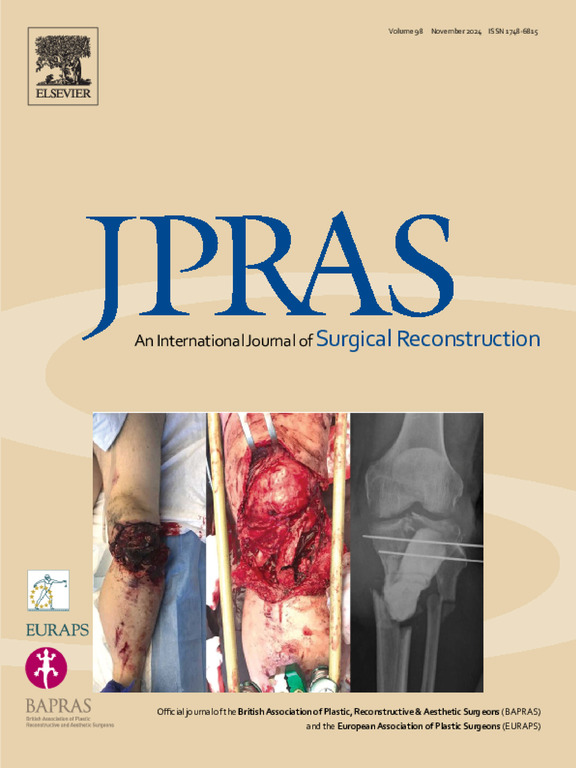Utility of the scratch collapse test for diagnosis of neurogenic thoracic outlet syndrome: Patient-reported outcomes after surgical treatment with at least 1 year follow-up
IF 2.4
3区 医学
Q2 SURGERY
Journal of Plastic Reconstructive and Aesthetic Surgery
Pub Date : 2025-07-28
DOI:10.1016/j.bjps.2025.07.024
引用次数: 0
Abstract
Introduction
This study introduces the Scratch Collapse Test as a diagnostic tool for Neurogenic Thoracic Outlet Syndrome (NTOS) and analyzes and evaluates functional and patient-reported outcomes with at least one year of post-surgical follow-up.
Methods
Forty-four consecutive patients who underwent surgery for NTOS were reviewed. Patients were contacted at least one year postoperatively and assessed using standardized patient-reported outcome measures (PROMs), including Visual Analog Scale (VAS) for pain, Derkash classification, Disabilities of the Arm, Shoulder, and Hand (DASH) score, Michigan Hand Outcomes Questionnaire (MHQ), and Cervical Brachial Symptom Questionnaire (CBSQ). Data were analyzed using t-tests and linear regression models.
Results
The NTOS site of involvement was supraclavicular (SC) in 12 (27.3%) patients, infraclavicular (IC) in 16 (36.4%), and both (SC and IC) in 16 (36.4%). A distal compression site was treated in 20 (45.5%) patients. The overall success rate, as assessed through the Derkash classification, was 87.5%. The mean postoperative VAS score (2.6 + 3.2) was significantly improved from the preoperative VAS score (8.0 + 2.9). Mean postoperative DASH, MHQ, and CBSQ scores were 32.8 ± 21.8, 68.1 ± 26.5, and 39.2 ± 32.6, respectively. Multiple linear regression analysis showed that a longer duration of symptoms before surgery was the most significant factor for a higher mean postoperative VAS pain score.
Conclusion
Longer time to surgery was associated with higher postoperative VAS pain scores, suggesting that earlier surgical intervention in NTOS patients may be beneficial. Higher VAS scores were significantly correlated with poorer postoperative mid-term outcomes as assessed through the DASH, MHQ, CBSQ scores, and Derkash classification.
应用划痕塌陷试验诊断神经源性胸廓出口综合征:患者报告的手术治疗后随访至少1年的结果
本研究介绍了划痕塌陷试验作为神经源性胸廓出口综合征(NTOS)的诊断工具,并通过至少一年的术后随访分析和评估功能和患者报告的结果。方法对44例连续接受手术治疗的NTOS患者进行回顾性分析。术后至少一年与患者联系,并使用标准化的患者报告结果测量(PROMs)进行评估,包括疼痛的视觉模拟量表(VAS)、Derkash分类、手臂、肩部和手部残疾(DASH)评分、密歇根手部结局问卷(MHQ)和颈肱症状问卷(CBSQ)。数据分析采用t检验和线性回归模型。结果NTOS受累部位为锁骨上(SC) 12例(27.3%),锁骨下(IC) 16例(36.4%),锁骨下和锁骨上均受累16例(36.4%)。20例(45.5%)患者接受了远端压迫部位治疗。通过Derkash分类评估的总成功率为87.5%。术后VAS平均评分(2.6 + 3.2)较术前VAS评分(8.0 + 2.9)显著提高。术后平均DASH、MHQ、CBSQ评分分别为32.8±21.8、68.1±26.5、39.2±32.6。多元线性回归分析显示,术前症状持续时间较长是术后VAS疼痛平均评分较高的最显著因素。结论手术时间越长,术后VAS疼痛评分越高,提示NTOS患者早期手术干预可能是有益的。通过DASH、MHQ、CBSQ评分和Derkash分级评估,VAS评分越高,术后中期预后越差。
本文章由计算机程序翻译,如有差异,请以英文原文为准。
求助全文
约1分钟内获得全文
求助全文
来源期刊
CiteScore
3.10
自引率
11.10%
发文量
578
审稿时长
3.5 months
期刊介绍:
JPRAS An International Journal of Surgical Reconstruction is one of the world''s leading international journals, covering all the reconstructive and aesthetic aspects of plastic surgery.
The journal presents the latest surgical procedures with audit and outcome studies of new and established techniques in plastic surgery including: cleft lip and palate and other heads and neck surgery, hand surgery, lower limb trauma, burns, skin cancer, breast surgery and aesthetic surgery.

 求助内容:
求助内容: 应助结果提醒方式:
应助结果提醒方式:


